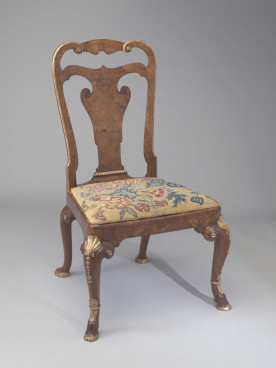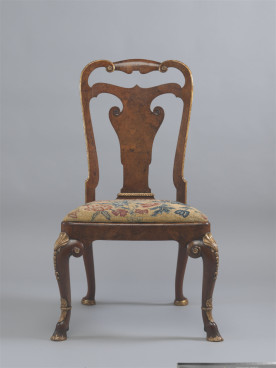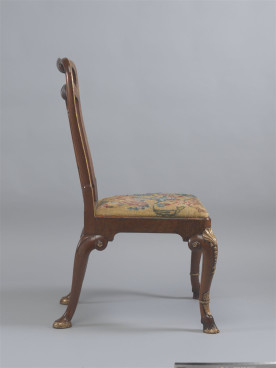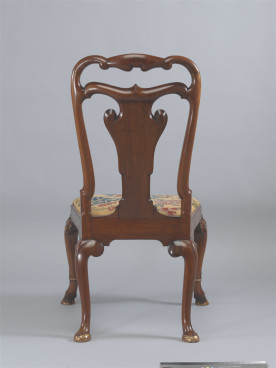Chair, c.1730–40
Walnut and parcel-gilt, now with 18th-century needlework
This chair is one of a pair from a larger set.
Adam Bowett Catalogue (19/08/2012)
Description
A pair of walnut and part gilt chairs, c.1730-40. The backs have waisted and scrolled posts over a baluster splat, cross-linked at the top to the posts. The slip seats are covered with floral needlework on a yellow ground, and raised on shell-carved cabriole legs with beaded, leafy gaiters and hoof feet.
Dimensions
H: 40 ½ ” (103cm) Seat height: 17 ¼ ” (44cm) W: 25 ” (63cm) D: 25 “ (63cm)
Materials
Walnut, beech
Dating criteria
Both the form and decoration of these chairs is typical of the early George II period, employing late baroque and neo-Palladian motifs.
Construction
The back legs and posts are solid walnut, veneered above the seat on the front face. The top rail is solid walnut, also veneered on the front face and mortised onto the tops of the back posts. The linking piece is solid walnut as is the splat. The splat is tenoned up into the linking piece and into the seat rail, where the shoe is fitted around it on three sides.The rear posts are pieced at the waist to create additional curvature. The back rail is solid walnut and tenoned into the back posts. The back legs have shaped walnut brackets supported behind by shaped glue blocks. The side rails are beech, tenoned into the front and back legs; the front rail is also beech and tenoned into the front legs. The rails are deeply rebated to create a raised edge which is faced with a short grain walnut ovolo moulding, and the faces of the rails are veneered with figured walnut. The front legs are solid walnut with shaped brackets and glued support blocks behind.
Marks or stamps
The top edges of the front seat rails are stamped III (17.1) and VIII (17.2) numerals.
Condition
17.1 – There are various stress cracks on the front face of the back related to the positions of the joints between the components. Replaced veneer centre right of top rail. Historic worm damage to seat rails and tops of the legs, repaired break to front left leg, some supporting blocks to legs probably replacements. The frame of slip seat is beechwood, warped out of shape and numbered in roman numerals, probably original. Needlework not original on either chair.
17.2 There are stress cracks on the front face of the back related to the position of the joints between the components. The joint between the crest rail and the right back post has been broken and repaired. Back left leg bracket is replaced, as is the blocking behind. There is a slight fracture to the top of the front right leg. Right front leg bracket possibly replaced. Stress fractures to veneers at the top of both front legs. Gilding almost certainly retouched throughout. Slip seat frame is possibly original, but warped and distressed, it is numbered III.
Additional remarks
A somewhat unusual design, particularly in the way in which the splat is not connected to the crest rail, but stops short and is linked to the back posts. The use of part-gilding is relatively common, and the design of the legs a sophisticated combination of late baroque Parisian motifs (the hoof foot) and neo-Palladian iconography (the shell knee).
References
Herbert Cescinsky, English Furniture of the 18th century, 3 Vols., New York (1912), III, p. 26, fig. 8.
Herbert Cescinsky, The Old World House, New York, 1924., pl. 41.
Herbert Cescinsky, English Furniture From Gothic to Sheraton, New York, 1937, p. 177 1929, p. 192
Exhibited New York, Art Treasures Exhibition, 24th May – 7th June 1967, no. 41.
Provenance
Purchased Ronald Phillips 6th October 2004












